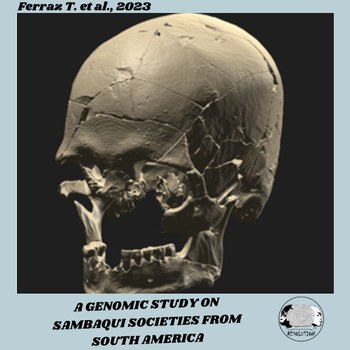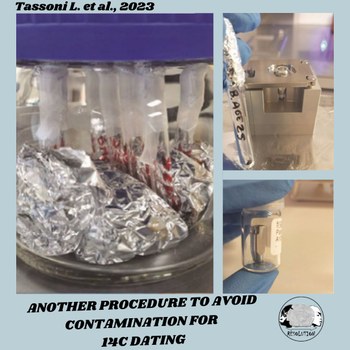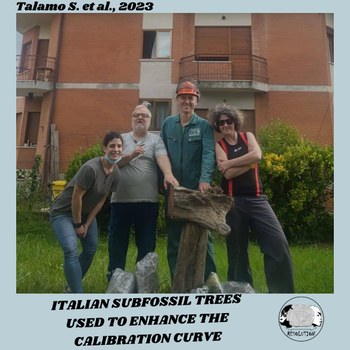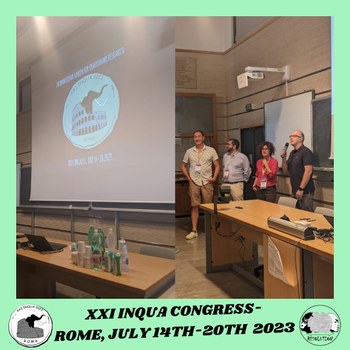
Check out what a new genomic database of 10,000 year-old individuals as well as radiocarbon dating unvealed about the history of these communities. Click the title of the paper, "Genomic history of coastal societies from eastern South America", or scroll the abstract below ⤵️
Abstract
Sambaqui (shellmound) societies are among the most intriguing archaeological phenomena in pre-colonial South America, extending from approximately 8,000 to 1,000 years before present (yr BP) across 3,000 km on the Atlantic coast. However, little is known about their connection to early Holocene hunter-gatherers, how this may have contributed to different historical pathways and the processes through which late Holocene ceramists came to rule the coast shortly before European contact. To contribute to our understanding of the population history of indigenous societies on the eastern coast of South America, we produced genome-wide data from 34 ancient individuals as early as 10,000 yr BP from four different regions in Brazil. Early Holocene hunter-gatherers were found to lack shared genetic drift among themselves and with later populations from eastern South America, suggesting that they derived from a common radiation and did not contribute substantially to later coastal groups. Our analyses show genetic heterogeneity among contemporaneous Sambaqui groups from the southeastern and southern Brazilian coast, contrary to the similarity expressed in the archaeological record. The complex history of intercultural contact between inland horticulturists and coastal populations becomes genetically evident during the final horizon of Sambaqui societies, from around 2,200 yr BP, corroborating evidence of cultural change.

Take your time to have a look at "SAFE PREPARATION AND DELIVERY OF GRAPHITE TARGETS FOR 14C ANALYSIS: PROCEDURES OF BRAVHO LAB AT BOLOGNA UNIVERSITY" on Radiocarbon or read the abstract below ⤵️
Abstract
Nowadays, most radiocarbon (14C) laboratories can reliably avoid and remove any possible sample contamination during the pretreatment of organic samples (e.g., bones, charcoal, or trees) thanks to a series of methods commonly used by the radiocarbon community. However, what about the final step, the storage of graphite? Rarely do the laboratories produce their graphite and ship it as pressed targets to accelerator mass spectrometry (AMS) facilities for measurement. Pressed graphite in aluminum targets are vulnerable to contamination, and during shipment or storage, exogenous carbon can be introduced again. Here we report a test on various archaeological sample materials from different environments and different periods (from the past three millennia to the Middle Paleolithic period). We transformed them into graphite, pressed the graphite into targets and sent them to two different AMS laboratories to be dated. We observe that packing details of the targets, extended shipment and storage time may lead to contamination which can be avoided by appropriate packaging in tight metal cans and sealed in vacuum bags. Close cooperation and coordination between our chemistry laboratory and the AMS facilities, high standards in contamination removal, and efficient measurement planning enabled us to obtain reliable 14C ages within a short time.

Find out how crucial these Italian subfossil tree samples were to enhance the calibration curve between 18,475 and 17,350 calendar years BP. Click here to read the entire article or have a look at the abstract below ⤵️
Abstract
Radiocarbon dating provides a key chronological framework for studying past environmental changes. Raw radiocarbon ages measured in samples must be converted to calendar ages using an appropriate calibration curve. Tree-ring datasets provide the gold-standard for developing a precise curve of atmospheric radiocarbon levels over long-time scales. Here, we reconstruct atmospheric radiocarbon levels using a millennium-long section of tree-ring chronology segments that extend into the last glacial period. The samples were obtained from subfossil larch trees recovered from clay quarries at Revine, Italy. Our reconstruction shows higher variations in the amplitude of atmospheric radiocarbon between 18,475 and 17,350 calendar years before the present than that detected in the IntCal20 calibration curve. Comparing the new tree-ring based reconstruction with Beryllium-10 fluxes derived from ice cores, we hypothesise that these variations are driven by solar variability. Our results demonstrate the unique value of sub-decadal radiocarbon sequences derived from glacial tree-ring chronologies.

Check out the INQUA website to read the full program of the conference and have a look on its Ig page for other details. But do not miss everything about all the talks delievered during our Session 87 "Prehistoric hunter-gatherers’ adaptation during the Last Glacial in Europe" by clicking here and visit our Twitter as well!